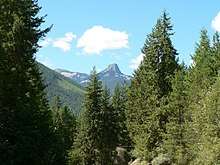Slocan Valley
The Slocan Valley is a valley in the West Kootenay region of British Columbia, Canada. The valley is home to the villages of Slocan City, New Denver, Silverton, as well as the unincorporated communities of Crescent Valley, Slocan Park, Passmore, Vallican, Winlaw, Appledale, Perry Siding, Lemon Creek, Rosebury, and Hills.

Valhalla Provincial Park is located on the western side of the upper part of the valley, and is adjoined on its south by the valley of the Little Slocan River. Just east of Slocan Lake are the ghost towns of Sandon, Cody and others, which were busy mining towns during the silver- and galena-mining era known as the Silvery Slocan (1890s–1900s).
Name
The word slocan is derived from the Sinixt dialect word meaning "pierce, strike on the head", a reference to the harpooning of salmon.
Geography
The Slocan Valley is about 105 kilometres long, and 5 to 10 kilometres wide. It is one part of the 400 km-long Kootenay Arc, made of sedimentary, volcanic and metamorphic rock. The Slocan Valley is located in the Selkirk Mountains which were created 200 million years ago, during the Jurassic period.
History
The valley has been the home of the Sinixt people since time immemorial. When silver was discovered near Sandon in the 1890s, thousands of prospectors arrived in the valley, but by 1910, many of the small towns had become deserted. Larger silver-base metals mines produced through the 1970s e.g. the Ottawa mine[1] and the Arlington mine on Springer Creek and the Enterprise mine on the namesake creek. Since then, a legacy of settlement from people disaffected with government has occurred in the Slocan Valley. A group of pacifists, the Doukhobors (originally a Russian sect of Christianity) arrived to farm in nearby Brilliant in 1908 and later spread into the Slocan Valley. During the Second World War, a policy of Japanese Canadian Internment saw many Japanese Canadians (including a young David Suzuki) re-located to internment camps in the valley, some of whom have stayed. In 1967 self-proclaimed war resisters of the Vietnam War, attracted to the Green Power movement (see Maclean's Magazine May 1968) and welcomed by the existing contingent of Russian pacifists, started making the valley their home. Since the 1970s, the population has steadily increased as telecommuters, commuters, people interested in a rural lifestyle and the children of earlier immigrants have worked to make themselves a suitable home.
Tourism
The Slocan Valley is a stop spot for tourists. Popular activities include mountain biking, rafting on the Slocan River, back country skiing, rock climbing at the Slocan Bluffs, and access to the Valhalla Provincial Park.
References
External links
- Slocan Valley Community
- Slocan Valley at britishcolumbia.com
| Wikimedia Commons has media related to Slocan Valley. |